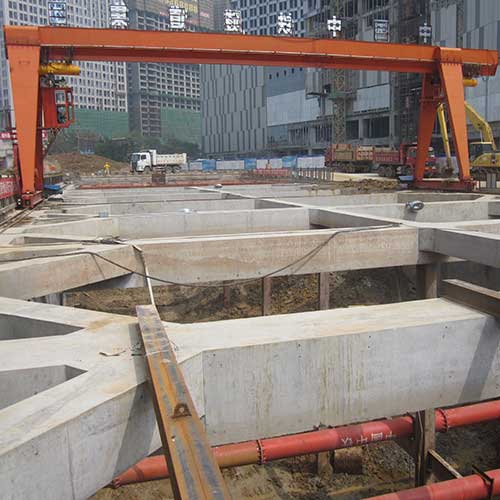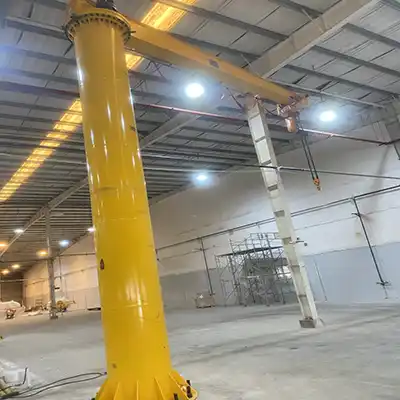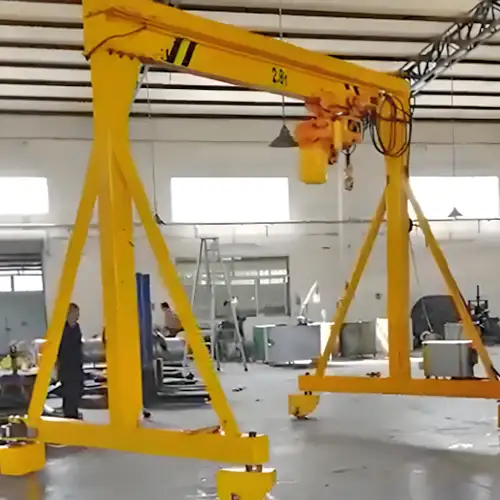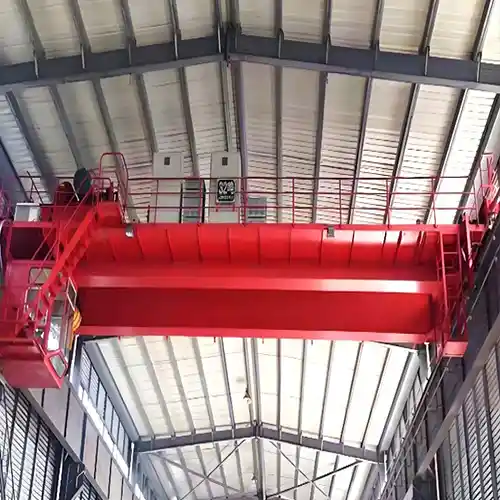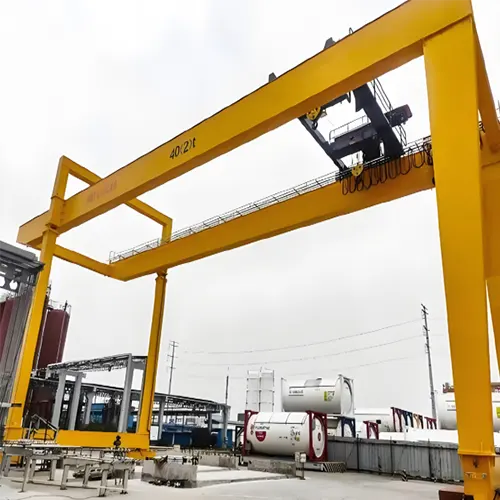Overhead Crane Selection & Management Maximize Construction Project Efficiency
Construction industrial overhead crane overview on essential aspects of overhead crane selection & management in construction project contracting.
Category: Construction
Your Trusted Overhead Crane Manufacturer & Supplier
Overhead Crane Selection & Management Maximize Construction Project Efficiency
Construction industrial overhead crane overview on essential aspects of overhead crane selection & management in construction project contracting.
Maximizing Construction Project Contracting Efficiency Through Overhead Crane Selection and Management
Overview of overhead crane for construction industry involving essential aspects of overhead crane management in the context of construction project contracting. It will help readers understand the critical role of cranes in construction and how making informed decisions about crane design, purchasing, installation, and maintenance can lead to successful project outcomes.
In the world of construction, where precision, efficiency, and safety are paramount, the role of overhead cranes cannot be overstated. These powerful pieces of equipment serve as the backbone of any construction project, enabling the efficient movement of heavy materials, machinery, and components. But beyond their physical presence on the job site, overhead cranes play a pivotal role in the broader context of construction project contracting.
In this article, we delve into the multifaceted world of overhead cranes and their profound impact on construction project contracting. We will explore how the design, purchasing, installation, and maintenance of overhead cranes can be pivotal factors in determining the success of construction endeavors. From towering bridge cranes to nimble jib cranes, each type has a unique role to play, and understanding their intricacies is crucial for construction professionals aiming to maximize efficiency, meet project deadlines, and adhere to budgets.
Overhead Crane Types and Design Considerations
When it comes to construction projects, one size does not fit all when selecting overhead cranes. The diverse array of overhead crane types, each with its unique features and applications, allows for precise customization to meet the demands of various construction scenarios.

- Suitability: Bridge cranes, also known as overhead bridge cranes, are ideal for indoor construction settings. They offer high lifting capacities and are suitable for moving heavy loads across wide spans.
- Tailoring Design: The design of bridge cranes can be tailored to accommodate specific project requirements. Single-girder and double-girder configurations are available to balance capacity and cost.
- Factors Impacting Design: When designing bridge cranes, factors such as lifting capacity (typically ranging from 1 to 20+ tons), span width (customizable to project needs), hook height, and crane speed must be carefully considered. Special features like radio controls or automated systems can enhance efficiency.

- Suitability: Gantry cranes, including mobile gantry cranes, are versatile and well-suited for outdoor construction projects. They provide mobility and flexibility in material handling.
- Tailoring Design: Gantry crane design can be adapted to meet specific project requirements, such as the need for mobility across uneven terrain or between work zones.
- Factors Impacting Design: Key design considerations include lifting capacity, span width, height under the hook, and mobility features (wheeled or track-mounted). These cranes are often used for lifting heavy materials like steel beams or precast concrete elements.

- Suitability: Jib cranes are known for their compact design and are often used in smaller construction sites or for localized material handling.
- Tailoring Design: Jib crane design can be customized based on the workspace layout and the specific materials to be handled.
- Factors Impacting Design: Factors like the crane's capacity, reach (span), and rotation angle need to be considered during design. These cranes are valuable for precise material positioning within a confined area.
Each of these crane types offers distinct advantages and is suitable for specific construction scenarios. Tailoring the design of these cranes to match project requirements, considering factors like capacity, span, height, and any special features, is essential to ensure efficient and safe material handling in construction projects. The careful selection of the right crane type and design can significantly impact a project's success.
Purchasing the Right Overhead Crane
Purchasing the right overhead crane is a critical step in construction project contracting. The choice made during this process can significantly impact project budgets, timelines, and overall efficiency. Here's a comprehensive guide to navigating the purchasing process effectively:
Needs Assessment:
- Begin by conducting a thorough needs assessment. Define the project's material handling requirements, including the types and weights of materials to be moved, the frequency of lifts, and any special handling considerations.
- Consider the workspace layout, available clearances, and any specific site conditions that may impact crane selection.
Budget Considerations:
- Determine a budget for the overhead crane. Consider not only the initial purchase cost but also long-term operating and maintenance expenses.
- Be prepared to balance your budget with the need for a crane that meets project requirements.
Procurement Process:
- The procurement process typically involves several stages: request for quotation (RFQ), supplier selection, negotiation, and finalization of the purchase agreement.
- Clearly outline project requirements and specifications in the RFQ to ensure suppliers provide accurate quotes.
Impact on Budgets and Timelines:
- Understand that the procurement process can impact project budgets and timelines. Delays in crane delivery or unexpected costs can affect project schedules.
- Make allowances for potential delays in the procurement process and communicate these to project stakeholders.
Evaluating Crane Suppliers:
- Research and evaluate potential crane suppliers to ensure they align with your project's needs and expectations.
- Factors to consider include supplier reputation, experience in similar projects, and the availability of support services.
Reputation and Track Record:
- Seek suppliers with a strong reputation for delivering high-quality cranes and meeting project specifications.
- Request references or case studies from previous projects to gauge a supplier's track record.
Experience and Expertise:
- Choose suppliers with extensive experience in designing, manufacturing, and installing overhead cranes.
- An experienced supplier is more likely to provide expert guidance during the selection process.
Support Services:
- Evaluate the availability of after-sales support and maintenance services offered by the supplier.
- Maintenance and support services are crucial for keeping the crane in optimal working condition.
Compliance and Safety:
- Ensure that the chosen supplier complies with industry standards and safety regulations.
- Safety is paramount in construction projects, and the crane must meet all safety requirements.
Warranty and Spare Parts:
- Review the warranty terms and conditions offered by the supplier.
- Inquire about the availability of spare parts to minimize downtime in case of repairs.
Customization Options:
- If your project has unique requirements, discuss customization options with the supplier.
- Customized features can enhance crane performance and adaptability to project needs.
Contracts and Agreements:
- Carefully review all contracts and agreements with the chosen supplier.
- Ensure that the terms and conditions are clear, covering aspects such as delivery schedules, payment terms, and warranties.
Purchasing the right overhead crane is a pivotal decision that can influence the efficiency and success of construction projects. By conducting a needs assessment, setting a realistic budget, and carefully evaluating crane suppliers, you can make informed choices that align with project objectives and minimize potential disruptions to budgets and timelines. Remember that the procurement process is not just about buying equipment; it's about securing a reliable partner for your construction project.
Installation and Integration
The installation and integration of overhead cranes into the construction site are critical phases that demand careful planning and execution. These steps have a profound impact on project schedules, safety, and overall operational efficiency.
Importance of Proper Installation:
- Proper crane installation is vital to ensure safe and efficient material handling.
- Inaccurate installation can lead to operational issues, delays, and safety hazards, jeopardizing project success.
Impact on Project Schedules:
- Delays in crane installation can disrupt project schedules, causing ripple effects on other construction activities.
- Timely and precise installation is essential to maintain project timelines.
Safety Considerations:
- Safety is paramount during crane installation. Adherence to safety protocols and regulations is non-negotiable.
- Properly installed cranes reduce the risk of accidents and injuries on the construction site.
Site Layout and Planning:
- Prior to installation, assess the construction site layout to determine the optimal crane placement.
- Consider factors such as clearances, access roads, and the proximity of materials to be lifted.
Foundation Requirements:
- Ensure that the crane's foundations are constructed to withstand the crane's weight and the loads it will lift.
- Foundation design and construction must adhere to engineering specifications.
Structural Integration:
- If the crane needs to be integrated with existing structures, careful planning and engineering are essential.
- Modifications or reinforcements may be necessary to ensure structural integrity.
Electrical and Control Systems:
- The electrical and control systems of the crane must be integrated into the construction site's power supply and control network.
- Coordination with electricians and automation specialists is crucial.
Testing and Commissioning:
- After installation, rigorous testing and commissioning are necessary to verify the crane's functionality and safety.
- Testing includes load testing and ensuring that all control systems work correctly.
Operator Training:
- Train crane operators thoroughly on safe and efficient operation.
- Well-trained operators contribute to enhanced productivity and reduced risk.
Maintenance Considerations:
- Develop a maintenance plan and schedule for the crane to keep it in optimal working condition.
- Regular inspections and preventive maintenance reduce the risk of unexpected breakdowns.
Compliance and Regulations:
- Ensure that the crane installation complies with all relevant regulations, including safety, environmental, and industry standards.
- Non-compliance can result in legal issues and project delays.
Project Coordination:
- Effective coordination between various project stakeholders, including crane suppliers, construction managers, and site engineers, is crucial for seamless installation.
Contingency Planning:
- Develop contingency plans to address unforeseen challenges during installation.
- Having backup solutions in place can minimize disruptions to project schedules.
Proper installation and integration of overhead cranes are integral to construction project success. These processes demand meticulous planning, adherence to safety protocols, and collaboration among project teams. By addressing site-specific requirements, considering safety at every step, and ensuring that the crane is seamlessly integrated into the construction site's infrastructure, you can maximize efficiency and mitigate potential issues during the project's execution.
Overhead Crane Maintenance and Safety:
Regular maintenance and a strong focus on safety are paramount when it comes to overhead cranes in construction projects. Here, we delve into the critical aspects of maintenance and safety to ensure crane reliability and project success.
Maintenance for Reliability:
- Regular maintenance is the backbone of crane reliability. It prevents unexpected breakdowns and ensures that the crane operates optimally.
- Establish a comprehensive maintenance schedule that includes routine inspections, lubrication, and component replacement as needed.
Safety Features and Practices:
- Overhead cranes come equipped with safety features to protect operators, workers, and the construction site. Familiarize crane operators with these features and their importance.
- Best practices for crane operation include maintaining safe distances from loads, using proper signaling, and following load capacity guidelines.
Preventing Downtime and Delays:
- Downtime due to crane malfunctions can be costly in terms of project delays and increased expenses.
- Proactive maintenance reduces the risk of unplanned downtime, ensuring that the crane contributes to project efficiency.
Inspection and Testing:
- Regular inspections are essential to identify potential issues before they escalate. Inspections encompass visual checks, structural evaluations, and electrical system assessments.
- Load testing, conducted at specified intervals, verifies that the crane can safely handle its maximum load capacity.
Lubrication and Component Replacement:
- Lubrication of moving parts is crucial to prevent wear and tear. Follow manufacturer recommendations for lubrication schedules and appropriate lubricants.
- Replace worn-out or damaged components promptly to maintain crane reliability.
Safety Training:
- Ongoing safety training for crane operators and site personnel is non-negotiable.
- Training should cover safety protocols, emergency procedures, and the correct operation of the crane.
Emergency Response Planning:
- Develop and communicate clear emergency response plans in case of crane-related incidents.
- Ensure that personnel are trained to respond swiftly and effectively to emergencies.
Compliance with Regulations:
- Stay current with safety regulations and standards applicable to overhead cranes.
- Regularly review and update safety procedures to align with the latest guidelines.
Record-Keeping:
- Maintain detailed records of crane maintenance, inspections, and any repairs.
- Documentation helps track crane performance, identify trends, and plan for future maintenance.
Communication and Reporting:
- Encourage open communication between crane operators, maintenance teams, and project managers.
- Promptly report any abnormalities or safety concerns for immediate action.
Proactive Problem-Solving:
- Adopt a proactive problem-solving approach to crane maintenance. Address potential issues before they lead to failures.
- Engage maintenance personnel in root cause analysis to prevent recurring problems.
Continual Improvement:
- Regularly review maintenance and safety practices for overhead cranes and seek opportunities for improvement.
- Incorporate lessons learned into future projects to enhance safety and efficiency.
By prioritizing regular maintenance and adhering to safety best practices, construction projects can maximize the reliability and safety of overhead cranes. A well-maintained crane contributes to project efficiency, minimizes downtime, and ensures that construction progresses smoothly and on schedule, ultimately benefiting the project's overall success.
Overhead Cranes and Project Contracting
The selection of overhead cranes is a pivotal aspect of construction project contracts, with far-reaching implications for project timelines, budgets, and overall success. Let's delve into how overhead cranes are interwoven with project contracting and the crucial considerations involved.
Crane Selection and Contracting:
- When drafting construction project contracts, the selection of overhead cranes is a critical decision. The contract should specify the type, capacity, and features of cranes required for the project.
- It's essential to align crane selection with the project's material handling needs and timelines.
Efficiency and Project Timelines:
- The efficiency and reliability of cranes directly impact project timelines. Delays due to crane malfunctions or inefficiencies can lead to contractual disputes and financial losses.
- Contracts should include provisions that address crane-related delays, including penalties for non-compliance with project schedules.
Budget Implications:
- Overhead cranes can have a significant impact on project budgets, both in terms of initial procurement and ongoing maintenance costs.
- Contracts should outline cost-sharing arrangements for crane-related expenses and specify how budget overruns will be managed.
Safety and Liability:
- Safety is a central concern in construction projects, and crane-related accidents can have severe legal and financial consequences.
- Contracts should clearly define safety responsibilities, including operator training, maintenance, and compliance with safety regulations.
Compliance with Standards:
- Contracts should stipulate that cranes must comply with industry standards, safety regulations, and any project-specific requirements.
- Non-compliance should trigger corrective actions or penalties outlined in the contract.
Maintenance and Downtime:
- Maintenance schedules and downtime allowances should be detailed in the contract to prevent disputes and minimize project interruptions.
- Contracts may include provisions for crane replacement in the event of prolonged downtime.
Reporting and Communication:
- Specify reporting mechanisms for crane-related issues, including breakdowns, accidents, and safety violations.
- Contracts may require regular communication between the crane supplier, operator, and project manager.
Performance Guarantees:
- Contracts can include performance guarantees for cranes, ensuring that they meet specified criteria for efficiency, reliability, and safety.
- Failure to meet performance benchmarks may trigger contract penalties.
Dispute Resolution:
- In case of disputes related to crane selection, operation, or maintenance, contracts should outline a clear dispute resolution process.
- Mediation, arbitration, or litigation procedures can be specified in the contract.
Documentation and Records:
- Contracts should mandate the maintenance of detailed records related to crane operations, maintenance, and safety.
- Documentation is essential for tracking compliance and resolving disputes.
Insurance and Indemnification:
- Specify insurance requirements for crane-related liabilities.
- Contracts may outline indemnification clauses to protect parties in case of crane-related accidents or disputes.
Change Orders:
- Recognize that crane-related requirements may change during the project due to unforeseen circumstances.
- Include provisions for change orders to accommodate crane modifications or replacements.
The selection, operation, and maintenance of overhead cranes are integral to construction project contracting. Contracts must meticulously address these aspects to mitigate risks, ensure project efficiency, and safeguard all parties' interests. Well-crafted contracts promote transparency, accountability, and successful project outcomes, ultimately serving as a cornerstone for construction project success.
Maximizing Efficiency and Benefits
Efficiency is the cornerstone of successful construction projects, and the right overhead crane can play a pivotal role in achieving it. In this section, we'll explore practical strategies for selecting, utilizing, and managing overhead cranes to maximize efficiency and reap long-term benefits.
Tailoring Crane Selection:
- When selecting overhead cranes, consider the specific requirements of your project. Bridge cranes, gantry cranes, and jib cranes each have unique advantages, so choose the type that aligns with your material handling needs.
- Assess factors like capacity, span, height, and any specialized features required for your construction tasks.
Efficiency in Material Handling:
- Optimize crane utilization by planning efficient material handling workflows. Ensure that cranes are positioned strategically to minimize travel distances and handling times.
- Implement just-in-time delivery strategies to reduce material storage and handling within the construction site.
Operator Training and Skill Development:
- Invest in comprehensive training for crane operators to enhance their skills and safety awareness. Well-trained operators can handle materials more efficiently and reduce the risk of accidents.
- Encourage continuous learning and skill development among crane operators.
Preventive Maintenance:
- Prioritize preventive maintenance to keep cranes in peak condition. Regular inspections, lubrication, and component replacement as needed can extend the lifespan of cranes and minimize downtime.
- Implement a proactive maintenance schedule that aligns with project requirements.
Real-Time Monitoring and Data Analysis:
- Utilize modern technology for real-time monitoring of crane performance. Data analysis can identify patterns and trends that enable proactive decision-making.
- Monitor factors like load capacity, energy consumption, and operator behavior to optimize crane usage.
Collaborative Planning:
- Collaborate closely with crane suppliers and project teams to ensure seamless integration of cranes into construction workflows.
- Engage in joint planning sessions to identify opportunities for process improvement.
Sustainable Practices:
- Consider sustainable practices when procuring and operating cranes. Energy-efficient cranes and environmentally friendly materials can contribute to a greener construction project.
- Implement recycling and waste reduction measures in crane-related activities.
Long-Term Investment:
- View crane procurement as a long-term investment. High-quality cranes may have a higher upfront cost but can yield substantial returns in terms of reliability and reduced maintenance expenses.
- Factor in the total cost of ownership over the crane's lifespan.
Risk Management:
- Implement risk management strategies related to crane operations, including contingency plans for crane breakdowns or accidents.
- Regularly review and update risk assessments as the project evolves.
Performance Metrics:
- Define key performance indicators (KPIs) for crane operations and track them throughout the project.
- KPIs can include metrics related to efficiency, safety, and cost-effectiveness.
Lessons Learned:
- Continually evaluate crane performance and gather feedback from project teams.
- Use lessons learned from one project to inform decisions and improvements in future projects.
Selecting the right crane type, optimizing its utilization, and embracing a proactive approach to maintenance and management can significantly enhance project efficiency. These efforts translate into cost savings, timely project completion, and the creation of a safer work environment. By focusing on the long-term benefits of well-planned crane procurement and management, construction projects can achieve sustainable success and lasting value.
Conclusion
In the realm of construction projects, the significance of overhead cranes cannot be overstated. They are the unsung heroes, facilitating the movement of materials and equipment with precision and power. Throughout this article, we've explored the multifaceted role of overhead cranes and how their design, purchasing, installation, maintenance, and efficient utilization can influence the success of construction project contracting.
- Design Matters: The choice of overhead crane type and design should align with project requirements, material handling needs, and safety considerations. A well-designed crane can enhance project efficiency.
- Procurement Precision: The procurement process for overhead cranes should be meticulous. It's not just about buying a machine; it's about investing in project success. Evaluate crane suppliers carefully, considering reputation, experience, and support services.
- Safe and Sound Installation: Proper crane installation is vital for project schedules and safety. Integration with existing infrastructure should be seamless, and safety protocols must be upheld rigorously.
- Maintenance is Non-Negotiable: Regular maintenance ensures crane reliability and minimizes downtime. Prioritize preventive maintenance and real-time monitoring to avert disruptions.
- Contracting Considerations: When drafting construction project contracts, crane selection, operation, and maintenance should be clearly defined. Contracts should address safety, efficiency, compliance, and dispute resolution.
- Efficiency is Key: To maximize efficiency, tailor crane selection, optimize material handling workflows, invest in operator training, and monitor performance in real-time. Sustainable practices and risk management play vital roles.
- Long-Term Vision: View crane procurement as a long-term investment. High-quality cranes may have higher initial costs but can yield significant benefits over their lifespan.
In closing, the success of construction project contracting is intricately tied to overhead cranes. Every decision regarding crane design, procurement, installation, and maintenance can tip the scales toward success or challenges. It's essential to recognize the profound impact that overhead cranes have on project timelines, budgets, safety, and overall efficiency.
As you embark on your construction projects, consider the lessons shared here and seek expert guidance when needed. Overhead cranes are not just tools; they are enablers of construction project excellence. By harnessing their potential through informed decisions and meticulous management, you can build the future with confidence and precision.
Main Projects
Related Products

Supplied three grab bucket crane kits to Indonesia, enhancing garbage handling efficiency with high load capacity and reliable performance.
Free consultation to Confirm Parameters & Specifications and Get
Latest Crane Price & Crane Rate.
- Types of overhead cranes : _______?
- Optional: Overhead travelling crane, goliath gantry crane,Slewing jib crane, Single girder or double girder crane,small portable crane or kbk crane, etc.
- Capacity of overhead crane: _______?
- Optional: 0.25ton, 0.5 ton, 1 ton, 2 ton, 3ton, 5 ton, 10 ton,15ton, 20ton, 25 ton, 30ton,35ton, up to 550ton, etc.
- Crane span & lifting height : _______?
- Crane travelling length : _____?
- Control of overhead crane:_______?
- Optional: pendant/ remote/cabin control
- Voltage supply of overhead crane:_____?
- Eg,: 380V50/60HZ,3Phase or others,etc.
- Application/usage of crane:_______?
- Eg,: Steel mill, ,injection mold, cement,stone, concrete,granite, general manufacturing, etc.
Just leave a message via the contact form and our hoist and crane engineer will contact you with in 24working hours.
Get In Touch
